Key takeaways:
- Unique travel photography tells stories and evokes emotions, connecting viewers to different cultures and landscapes.
- Aerial photography provides a crucial perspective, revealing patterns and relationships between geography and culture while fostering conservation awareness.
- Essential tools for aerial photography include high-quality drones, gimbal stabilizers for stabilization, and filters for enhancing images.
- Effective planning, including timing, location scouting, and understanding weather conditions, significantly impacts the quality of aerial shots.
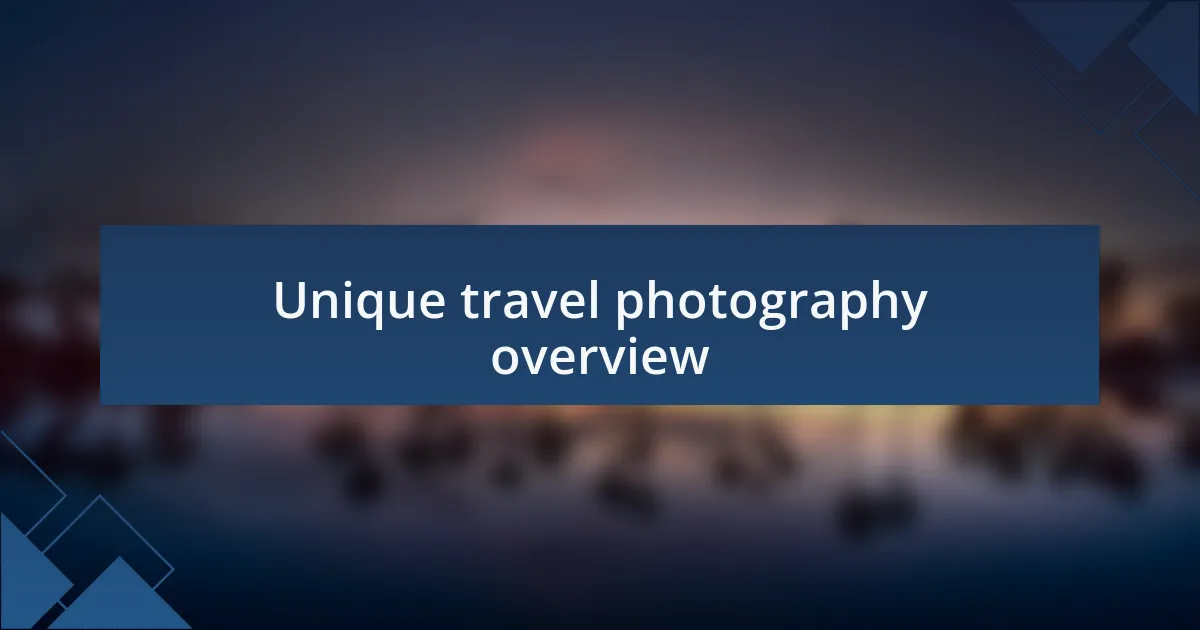
Unique travel photography overview
Unique travel photography goes beyond simply capturing sights; it tells stories and evokes emotions tied to experiences in different cultures and landscapes. I remember standing on a windswept cliff in Iceland, the vast ocean stretching endlessly before me. That moment, when I pressed the shutter, wasn’t just about the dramatic scenery; it was about preserving the raw sense of adventure I felt in that place.
Every destination offers a unique palette of colors, textures, and perspectives that can transform an ordinary scene into something extraordinary. Have you ever looked at a photograph and felt as if you were transported to that moment? That’s the power of unique travel photography—it invites viewers into a world they might never have seen themselves and connects them to the essence of a place.
In my experience, embracing local traditions and engaging with the community can lead to the most captivating imagery. For example, joining a traditional dance performance in Bali allowed me to capture not just the vibrant costumes but also the joy and connection within the group. It’s these intimate moments that truly make travel photography unique—moments that resonate long after the trip is over.
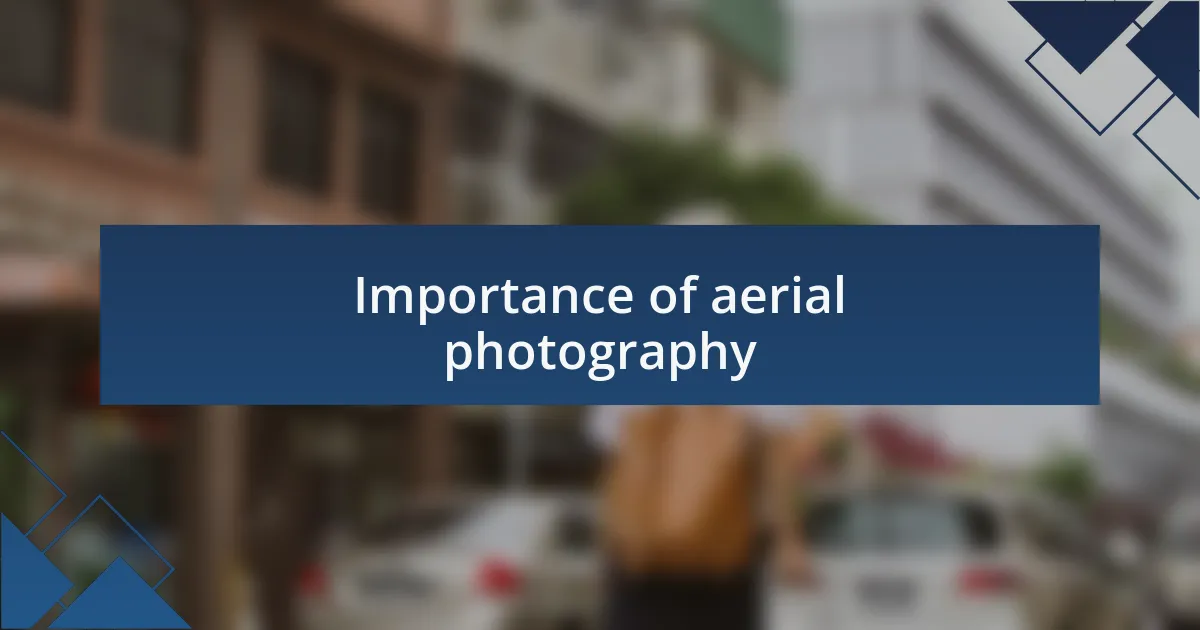
Importance of aerial photography
Aerial photography plays a crucial role in showcasing the grandeur of landscapes from a unique vantage point. During my travels, I’ve often found myself captivated by how a bird’s-eye view can reveal intricate patterns in nature that are invisible from the ground. Can you imagine witnessing the winding rivers of the Amazon or the sprawling fields of tulips in the Netherlands from above? This perspective not only enhances the aesthetic appeal but also provides context that enriches our understanding of the scenery.
One of the most significant aspects of aerial photography is its ability to tell a story about a place’s geography and culture. For instance, while photographing the ancient ruins of Machu Picchu from the air, I felt an overwhelming connection to the history of the Inca civilization. The layout of the site reflects their deep understanding of the landscape, which is something you truly grasp only when you see it from above. How often do we consider the relationship between people and their environment? Aerial views amplify that connection, providing a powerful narrative that ground-level shots simply cannot achieve.
Moreover, aerial photography can serve as an essential tool for conservation efforts. As I flew over the Great Barrier Reef, I was struck by both its beauty and its vulnerability. Aerial images can highlight the impact of climate change, helping to foster a greater appreciation for these natural wonders and the need to protect them. Isn’t it remarkable how a single photograph can inspire action and provoke thought? This is where the true importance of aerial photography lies—it not only captures stunning landscapes but also sparks conversations about their future.

Common aerial photography techniques
One common aerial photography technique I often use is the “drone flyover.” This method allows for stunning footage and images that capture expansive landscapes in a way that’s both dynamic and immersive. I remember flying my drone over the rocky cliffs of the Pacific Coast; the images I captured truly showcased the dramatic interplay of land and sea, revealing angles I’d never envisioned before. Have you ever noticed how different a familiar place looks from above?
Another technique that can’t be overlooked is the “helicopter or plane-based shooting.” This method offers a different perspective, often featuring high-altitude images that emphasize scale and depth. I once took a helicopter ride over the Grand Canyon, and the vastness of the canyon walls, dotted with shadows, was nothing short of breathtaking. The altitude provided an unparalleled sense of grandeur that you simply can’t replicate from the ground. Isn’t it fascinating how altitude changes our perception of beauty?
Lastly, I find the “tethered balloon technique” incredibly unique. It allows for a steady elevation and a close view, which is perfect for capturing vibrant colors and textures. During one of my trips, I floated high above a sunflower field, and the sight of those yellow blooms stretching endlessly was mesmerizing. Can you imagine how enchanting it is to feel the gentle sway of a balloon as you snap photos of a vibrant tapestry below? Each of these techniques has its own charm, adding layers to the storytelling power of aerial photography.
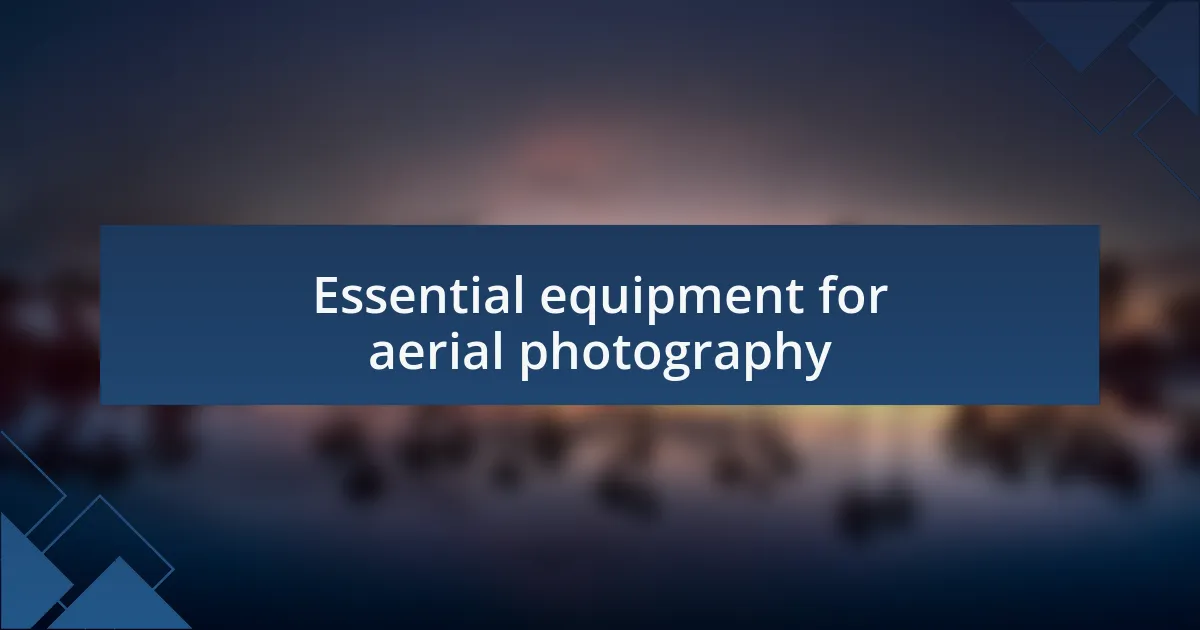
Essential equipment for aerial photography
When it comes to aerial photography, having the right equipment is essential. A high-quality drone with a reliable camera is a must-have for capturing stunning images from the sky. I remember my first drone—learning how to control it wasn’t always easy, but the thrill of nailing that perfect shot as it hovered over a serene lake made every moment of practice worthwhile. What equipment do you think significantly impacts your photography?
Beyond drones, investing in a solid gimbal stabilizer can make a world of difference. This device helps reduce camera shake, ensuring your aerial shots are smooth and professional-looking. I once failed to use a gimbal during a windy day shoot and ended up with blurry images. It was a frustrating but valuable lesson about the importance of stabilization in aerial photography. Have you ever dealt with shaky footage?
Lastly, a good set of filters can elevate your aerial photography. Polarizer filters, for example, help enhance colors and reduce reflections, which is particularly useful when shooting over water or wet surfaces. On one occasion, I used a polarizer while photographing a coastal sunset, and the colors burst to life in a way I hadn’t seen before. It reminded me that sometimes, small details can have a substantial impact on the final image. What kind of filters do you prefer to use when shooting from above?
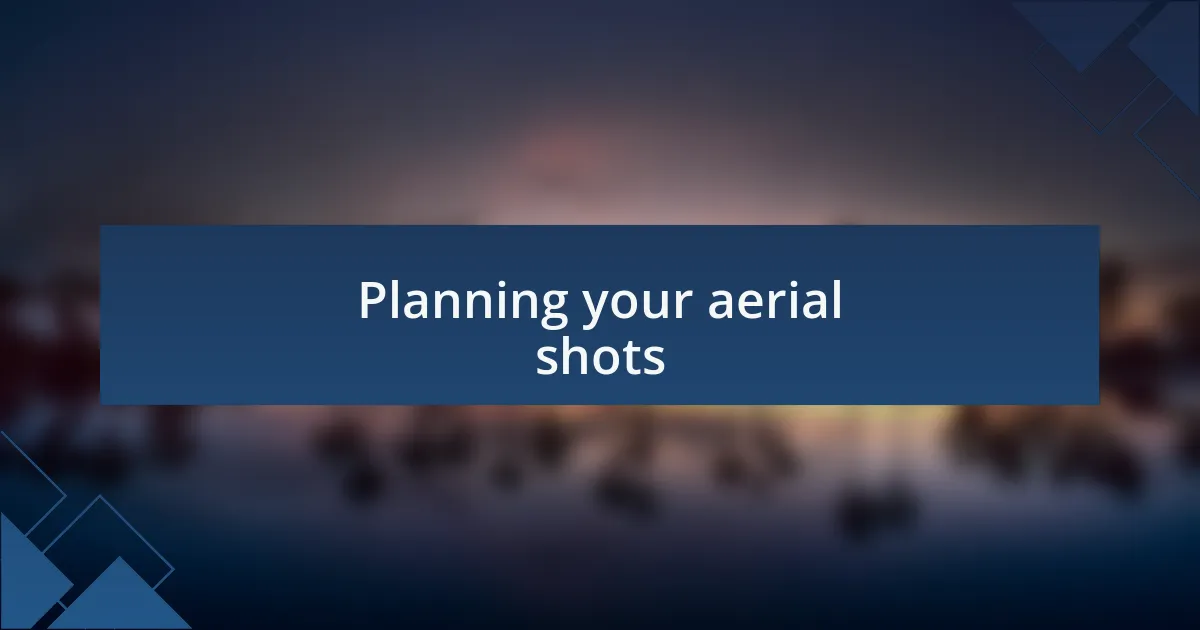
Planning your aerial shots
When planning your aerial shots, timing plays a crucial role. I often find that the golden hours—just after sunrise or before sunset—provide the most dramatic lighting. There’s something magical about how the soft, warm hues transform landscapes, making them look almost ethereal. Have you ever experienced that breathtaking moment when the light hits just right?
I cannot stress enough the importance of scouting locations ahead of time. Before I head out, I usually spend time researching potential spots using maps and apps. I remember a trip where I discovered an overlooked viewpoint that offered a breathtaking perspective over rolling hills. It was a delightful surprise, and it highlighted how preparation can lead to unexpected rewards. Have you ever stumbled upon a hidden gem during your travels?
Another significant factor is understanding the weather conditions. I’ve found that a cloudy or overcast day can yield beautifully moody shots that evoke strong emotions. During one of my aerial shoots, I faced unexpected clouds rolling in, but instead of getting discouraged, I adapted my vision. The results were atmospheric images I hadn’t anticipated. What weather conditions have you found to enhance your aerial photography?
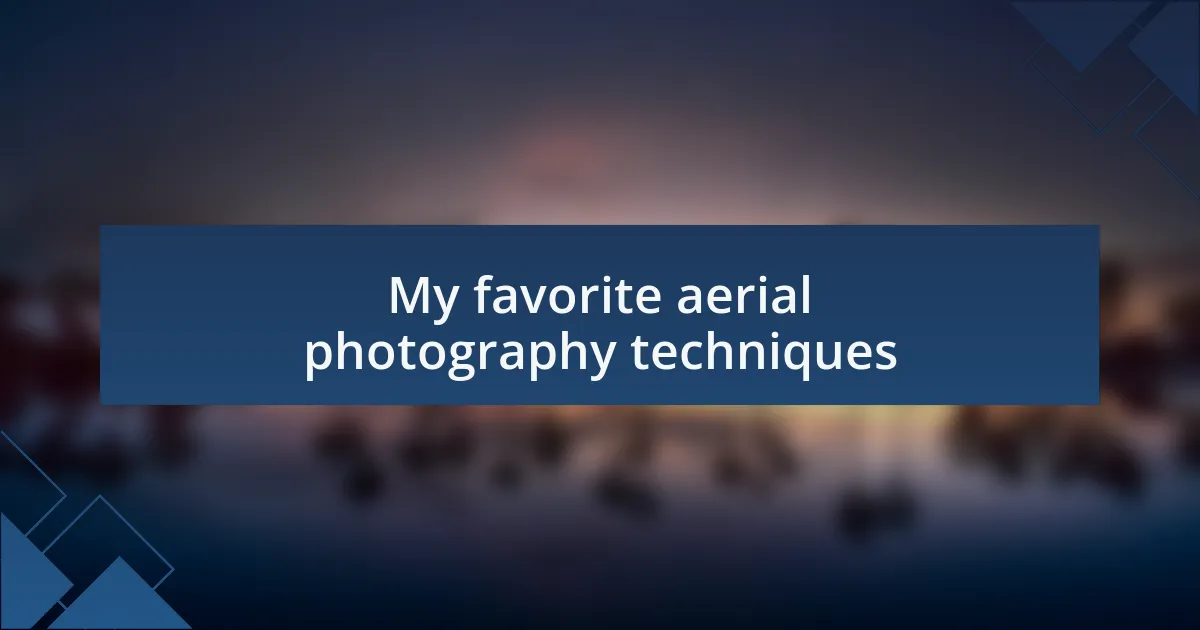
My favorite aerial photography techniques
One of my favorite techniques is experimenting with different altitudes. I’ve discovered that varying my height while flying can radically change the perspective of my shots. For instance, a low altitude can emphasize foreground details, while a higher vantage point often captures the grandeur of the landscape below. Have you ever noticed how slight changes in elevation can tell an entirely different story in a photograph?
I also love using leading lines to guide the viewer’s eye through the image. During one memorable shoot over a winding river, I positioned my drone to capture how the water snaked through lush green fields. The curves subtly drew my gaze and created a sense of depth that I found captivating. Isn’t it fascinating how a simple compositional element can add layers of intrigue?
Moreover, incorporating natural frames into my compositions has been a game-changer. While shooting a coastal scene, I remember using overhanging branches as a frame to highlight the crashing waves below. This technique doesn’t just add context; it invites the viewer into the scene, making them feel part of the adventure. Have you tried framing your shots in this way? It’s an approach I highly recommend for creating depth and intimacy in your images.
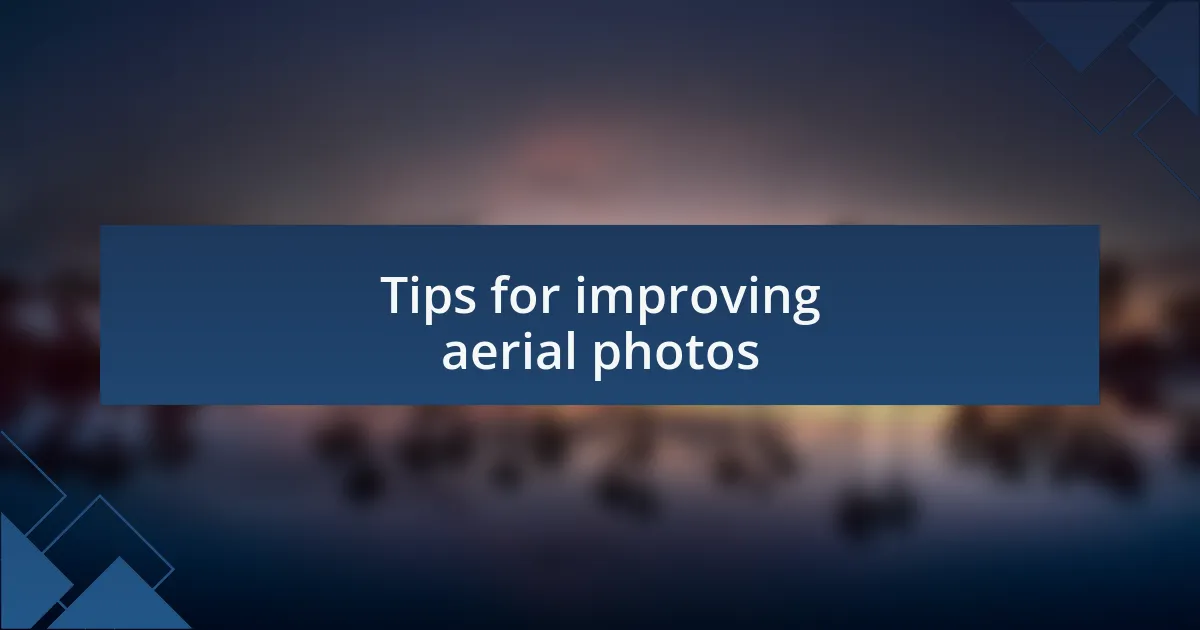
Tips for improving aerial photos
Capturing the perfect aerial shot often hinges on lighting conditions. I’ve found that shooting just after sunrise or before sunset transforms landscapes into vibrant canvases. The golden hour offers soft, rich hues that enhance colors and create stunning shadows, adding drama to your images. Have you ever experienced the magic of that golden light?
Another essential tip is to pay attention to your composition. I once took a series of aerial photos over a field of blooming tulips, and by simply shifting my drone slightly to the left, I was able to include a patch of wildflowers that popped against the vibrant colors. This small adjustment created a much more balanced and visually appealing image. Isn’t it interesting how a minor tweak can elevate an ordinary photo to something extraordinary?
Lastly, don’t overlook the importance of post-processing. After a particularly thrilling shoot over a mountain range, I took the time to fine-tune my images, adjusting contrast and saturation to make the colors sing. I believe it’s in those fine details where your style can truly shine. Have you experimented with editing your aerial photos to bring out their full potential?